Concentration - the size defining amount of the substance which is in solution. It is most often used in chemistry (for an experiment important that solution was prepared correctly), sometimes finds application in other sciences, and at times and in everyday life (to prepare the most exact solution of salt, sugar, soda, etc.).
It is required to you
- The textbook in analytical or general chemistry of any author.
Instruction
1. It should be noted that the composition of solution (or the content of the dissolved substance in solution) is expressed in different ways: dimensional and dimensionless sizes. Dimensionless sizes (shares, percent) do not belong to concentration since concentration - size dimensional. In chemistry generally use 3 types of concentration: molar concentration or molarity, molal concentration or molyalnost and equivalent or normal concentration. Molar concentration or molarity - the relation of amount of substance to solution volume. n/V where n is amount of substance, mol, V - the volume of solution, l is calculated by the Cm formula =. Also this concentration can be designated by letter M after number. So, for example, record of 5 M of HCl means that Cm (HCl) = 5 mol/l, i.e. 5 mol of HCl are in 1 l of water. Note: if in a task the amount of substance is not specified, but its weight is specified, then it is possible to use formula n = m/Mr where m is the mass of substance, Mr is the molecular weight (it is possible to count by means of D.I. Medeleev's table), n is amount of substance, mol. This concentration changes at increase or reduction of temperature.
2. Molal concentration or a molyalnost - the relation of amount of substance to the mass of solvent. It is calculated by formula m = n/M (solution) where n is amount of substance, mol, M (solution) - the mass of solution, kg. For example, m(HCl) = 5 mol/kg (H2O), means that 5 mol of HCl are the share of 1 kg of water. Solvent not necessarily is water (it depends on objective conditions), the amount of substance can be calculated (the way is specified in point the first), at a temperature the molal concentration does not change.
3. Equivalent or normal concentration - the relation of number of equivalents of the dissolved substance to solution volume. It is possible to designate normal concentration by Sn or a letter of N after number. For example, 3 N of NSl - solution in which each liter there are 3 equivalents of hydrochloric acid means. Calculation of an equivalent is a separate subject which if necessary can be found in the school textbook in chemistry. This concentration is often used in analytical chemistry when it is necessary to learn in what volume ratios to mix solutions: the dissolved substances have to react without the rest, i.e. C1*V1 = C2*V2 where C1 and V1 - concentration and volume of one solution, and C2 and V2 - concentration and volume of other solution. Using these types of concentration, it is possible to solve an objective.

